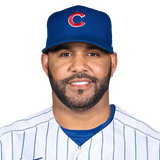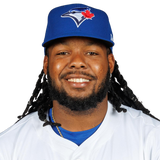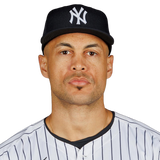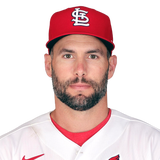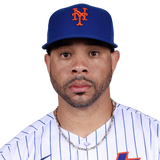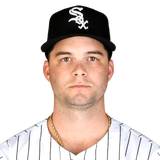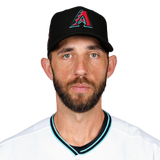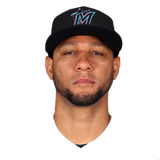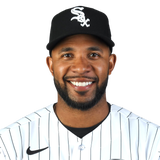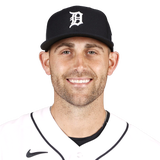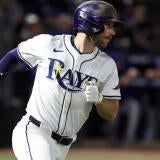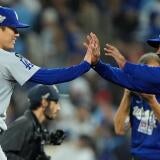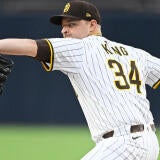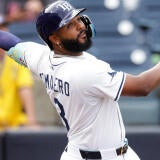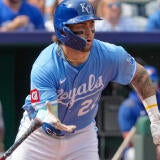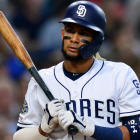| ||||||||||
2020 Fantasy Baseball Draft Prep: Busts 1.0 include rising stars like Fernando Tatis, Vladimir Guerrero
There are busts, and then there are Busts. Scott White thinks you can stave off disaster by avoiding these 12.
Already this preseason, I've written about players who are being overvalued by the drafting public, according to ADP. That particular column is a recent addition to our preseason lineup, having just been introduced a few years ago, but I'm grateful for it.
It means I don't have to waste my Busts column on something so nitpicky.
When I say a player is a possible bust, I don't want there to be any mistaking what I mean. I'm not just saying he'll be a little disappointing, like maybe you'll wish you had taken him a round or two later. I'm saying he has the potential to wreck you.
Obviously, that's a difficult standard to meet, so I'm taking some big, low-probability hacks here. I don't even necessarily dislike all of these players, but I do think their downside is on the more extreme side and should be factored into their cost accordingly. I doubt I'll be "right" about many of them, but given the alternatives available at their going rates, there isn't much downside to being wrong.
This Fernando Tatis pick is one of those that makes my particular definition of "bust" so critical to understand, because the chance of him being an impact player is much higher than not. But when I weigh the downside, particularly at his going rate of 18th overall, I don't know that he comes out ahead on the risk/reward spectrum. Yeah, maybe he turns out to be a five-category stud who's in the conversation to go No. 1 overall next year -- that's how things were looking for the 84 games he was healthy. But he finished the year with an impossible .410 BABIP.
True, it's 2020, and we know now that the way a hitter impacts the ball changes the likelihood of him delivering a high or low BABIP, but Tatis put the ball on the ground far too often to come out ahead there. Fittingly, his xBA was only .259 and his xwOBA only .345, neither of which would fit an early-round profile if not for the steals.
About them ... Tatis went 13 for 16 on stolen bases in his first 49 games, but only 3 for 6 in his final 35 -- and, no, the time he missed with a hamstring injury isn't the dividing line there. He just stopped running, as most power hitters do eventually, some sooner than others. If it's the new normal for him and the hitting regresses like the advanced stats say it should, he might not even be on Jorge Polanco's level among shortstops. A lot of ifs, sure, but none of them are far-fetched.
| ||||||||||
It's true only a small number of drafts have already taken place and it's true the ones that have may be skewed by stolen base derangement syndrome. Still, Jonathan Villar at 53rd overall still strikes me as a textbook case of those who haven't learned from history being doomed to repeat it. We've been down this road before with him, reaching into the fifth round for his stolen bases after a year in which he didn't hit so poorly, and it ended in disaster back in 2017.
Of course, that Brewers team was going places and couldn't afford to wait out his struggles. This Marlins team isn't. Still, as a hitter, he leaves plenty of reason for skepticism. He makes weak contact, he doesn't elevate, he's undisciplined. No surprise, then, that he greatly outperformed his peripherals last year. He has to play to run, and if he regresses to being more of a .240 hitter with poor on-base skills, the Marlins might turn center field over to one of their many outfield prospects nearing the bigs. The venue change doesn't help Villar's case either. We don't know exactly how the new dimensions at Marlins Park will play, but it won't be Camden Yards, where he hit 16 of his 24 home runs last year.
| ||||||||||
This one could clearly go either way. Vladimir Guerrero was almost universally regarded as the top prospect in baseball entering last year, and I went so far as to call him the best pure hitting prospect I've ever seen. Clearly, he disappointed. He didn't embarrass himself, but he disappointed, and he didn't just disappoint with the production. The actual skill indicators left something to be desired.
Now, that doesn't mean he didn't impress in any way. He put on a show during the Home Run Derby, as you might recall, and made contact at an uncanny rate for such a young hitter. He also authored some of the hardest hit balls in all the majors. But his average exit velocity was suspect and his average launch angle downright sad.
The problem is he's getting drafted like none of it happened, which might make sense if we were working with a weakened hitter pool and had to scour every nook and cranny for upside, but we're clearly not. In fact, third base is so deep that No. 15 in my rankings, Josh Donaldson, actually had higher point-per-game average last year than No. 9, Eugenio Suarez, so there are just redundancies all over.
Guerrero will eventually be a star, and maybe he improves his launch angle in Year 2 the way Juan Soto did and takes off. But it's unnecessary risk at a position where you can't go wrong waiting.
| ||||||||||
Because of an onslaught of injuries that began with a strained biceps in early April and let up only enough for him to play a week here and a week there, Giancarlo Stanton appeared in 18 regular-season games last year. It was a lost season -- one in which the sample was too small for the numbers to tell us anything -- and it came at a miserable time for one. He had something to prove after a first year with the Yankees that was defined more by his strikeout total (211) than his home run total (38).
Maybe it's unfair to characterize it that way. The strikeout rate, which was just shy of 30 percent, was in line with his 2016 and 2017, with his MVP-winning 2018 representing the outlier. But now he's 30, with an extensive injury history (see the calf strain early in spring training) and a strikeout proclivity that's only overcome by feats of extreme athleticism -- specifically, how hard he's able to hit the ball -- and I'm concerned that's a skill set that won't age well. I'm concerned Stanton goes the way of Ryan Howard, who profiled and produced similarly before beginning to fade at age 30. And since a .260 hitter with 40-homer potential isn't a game-changer in this environment anyway, I'm not taking the chance on it early.
| ||||||||||
Considering he's still going 62nd overall in early mock drafts -- ahead of Matt Olson, Josh Bell, Joey Gallo and several other first basemen who outperformed him on a per-game basis -- I get the sense Fantasy Baseballers are a little too sanguine about Paul Goldschdmidt's career-worst season. After back-to-back single-digit efforts, we can all rest comfortably in the knowledge he's not a base-stealer anymore, so it's the bat that has to carry him. And given the number of first basemen or just hitters in general with the capacity for 30-plus homers in today's environment, it needs to be a special bat to justify the upcharge.
I'm not sure it is. He's now 32 and playing his home games in a much tougher venue than where he spent most of his career. His exit velocity has been dropping little by little, but perhaps the clearest indication that his bat is slowing down is how pitchers are approaching him. He saw more first-pitch strikes than ever before, a sign they don't fear him like they once did, and had his worst swing-and-miss rate since his rookie season. Most concerning of all, though, is that he hit just .232 against four-seam fastballs. He's a career .309 hitter against them.
| ||||||||||
Pham is that disciplined sort of hitter who normally wins my undying affection, and longtime readers may remember he's the one I hyped to the hills during draft prep season just a couple short years ago. But I don't like the way things are trending for Pham, and it's easy to overlook, given his late start, that he'll be 32 on opening day. Once a player enters his 30s, he's at risk of rapid regression, sometimes without warning. So when there is warning, we need to take it seriously.
In an environment where fly balls seem to turn into home runs at random because the drag on the ball is so low, the players most at risk of being left behind are the ones who don't elevate. Pham was never great at this, but he has taken steps back the past two years, to the point his ground-ball rate was fourth-highest in baseball last year. That's Eric Hosmer territory. Add that he also had a career-worst barrel rate, and it's fair to ask how much longer home runs will be part of his skill set. He's obviously going to run less as he gets older, too. Shave a handful off those home run and stolen base totals, and there's not a lot separating Pham from, like, Brett Gardner.
| ||||||||||
There's a sentiment in the Fantasy-playing world that a player coming off a bad season couldn't possibly be a bust candidate. The bust already happened, and to declare it thereafter would be chasing the result. But what if I think Andrew Benintendi is genuinely as bad as his worst season? Would it matter, then, that you're getting a former top-10 outfielder around 30th at the position?
I can't overstate just how deep this hitter pool is. Big production is still available beyond the 25th outfielder -- Max Kepler, Michael Brantley and Michael Conforto, just to name a few at the same position -- and what Benintendi offered last year, by comparison, was miserable. The totals speak for themselves, but to use Head-to-Head scoring for simplicity's sake, his point-per-game average was worse than Jon Berti and Anthony Santander. And the advanced numbers say there was nothing unlucky about it. It wasn't just confined to last season either, contrary to popular belief. Since the All-Star break in 2018, he has contributed just 15 home runs and 14 steals over 770 at-bats.
Those numbers would be great from Nick Markakis, but from a top-100 pick, you have to get more. You have to. Yeah, at 25, there's still time for Benintendi to change course, but it's going to take a radical transformation that I'm not willing to bank on.
| ||||||||||
Rhys Hoskins gave his backers their victory lap when he homered 18 times in his first 34 games as a late-season call-up in 2017, but it's kind of been all downhill since then. The slide has been subtle, but it's undeniable now that he's just no good for batting average. The fly-ball tendencies are too extreme, his game totally reliant on the home run, and since he's not impacting the ball like an Aaron Judge or even a Pete Alonso, the hard-hit rate being decidedly middle of the pack, there aren't enough home runs to make up for all the outs on balls in play. It's how he managed to put together a four-month stretch beginning on June 1 last year in which he hit .198.
Nothing fluky about where his batting average ended up either. His .221 xBA was second-lowest among players with at least 500 plate appearances. He's also a liability defensively, so about the only thing saving him at a time when right-handed power hitters are totally dispensable is his knack for drawing walks, which led to an impressive .364 on-base percentage last year. That's obviously of little help in traditional Rotisserie leagues, though, and any drop-off there might get the Phillies sniffing around for alternatives.
| ||||||||||
Listen, I don't mean to be a total downer about Madison Bumgarner, who last year showed signs of regaining some of the skills he purportedly lost in the dirt bike accident of 2017. The velocity on his most pivotal pitch, the cutter, was back, averaging about what it did in 2016, his walk rate was back to being elite, and his swinging-strike rate, recovering from a nasty downward spiral, was actually the second-best of his career.
It didn't change the actual results, though. His strikeout rate wasn't great, and he was vulnerable to the long ball. His saving grace was that he pitched his home games at the friendliest of pitcher's parks, where he put together a 2.93 ERA compared to 5.29 on the road. The previous year was just as extreme, 1.63 compared to 4.97, which is why there's legitimate concern his move to Arizona could be the nail in the coffin. Again, it's not hopeless for Bumgarner, who's still only 30, but his going rate assumes he'll be the same guy he was in San Francisco last year.
| ||||||||||
This past year was a career year for Yuli Gurriel that placed him among the elite first basemen, top 10 in both 5x5 Rotisserie and Head-to-Head points leagues, and I can point to at least one skill change that backs it up. He elevated the ball more, improving his launch angle in deference to an era that favors fly balls. Still, power breakthroughs for 35-year-olds generally aren't something you should hang your hat on, and particularly when it's confined to such a small period of time. Of his 31 homers, 20 came during a 40-game stretch from Jun 23 through Aug. 14. He hit .267 with six home runs in 33 games the rest of the way.
Gurriel has his strengths, of course. He rarely strikes out, which makes him a reliable source of batting average. But prior to last year, the power was too limited for him to be more than a fringe contributor at first base. So there's substantial risk right there, just having to trust in the idea of a 40-game stretch being the new standard for a 35-year-old. Factor in that the Astros are trying to work Kyle Tucker into the lineup, with first base having been mentioned as a possibility, and Gurriel may not have so much job security if he regresses back to his former production, much less suffers the sort of decline that normally afflicts players his age.
| ||||||||||
Shortstop has become a star-studded position, offering more than enough to go around in a standard 12-team league. With that in mind, the only reason anyone might have to target Elvis Andrus where he's going, at 151st overall, is stolen base derangement syndrome. There's an urgency surrounding steals that compels otherwise right-minded people to do desperate and illogical things. It's true Andrus had 31 stolen bases last year. It's also true that the last time he had even 30 was 2013, but sure, let's just trust that they'll be there again.
And let's also trust that he'll hit while we're waiting around for them. Forget that he hit only in April of last year, putting together a month so productive that it papered over his .256 batting average and .640 OPS the rest of the way -- which is much closer to the .256 batting average and .675 OPS he had in 2018, mind you, when he had only five stolen bases in 97 games. Andrus may be 31, but having been an everyday player since age 20, he has put in a lot of miles at a demanding position. You don't want to be so hard up for steals that you have to devote your shortstop opening to him in the middle rounds.
| ||||||||||
This is another one that could go either way, and to be totally upfront, Matthew Boyd was also on my long list of candidates for Breakouts 1.0. I'll probably have a number of shares in him, and the reason I'll have those shares is because he's a genuine standout in all but one of the areas by which we've grown accustomed to measuring pitching ability. It's just that the one is such a big one that it could totally upend him.
It basically did in the second half. He went from being that breakout ace with the misfortune of playing for the Tigers to oh ... well, um, it was fun while it lasted. Or, actually, it started before then. Through 14 starts, he had a 3.08 ERA, 1.04 WHIP and 11.2 K/9, but then over his final 18 starts, he had a 5.81 ERA, 1.39 WHIP and 11.9 K/9. The big difference was the jump in HR/9, from 1.06 to 2.59. His season mark of 1.89 ended up edging out Mike Leake for worst in the majors. And since he was also second in fly-ball rate, it'd be difficult to dismiss as a fluke.
Now, first among fly-ballers was Justin Verlander, and that in and of itself is reason for hope. But home runs have long been a bugaboo for Boyd, and it may be that no matter how adept he becomes at missing bats, he's just not well-suited for today's home run barrage. Then when you factor in the likelihood of him having a losing record if he sticks with the Tigers, how high is the upside, really?
So which busts should you avoid in your draft? And which undervalued first baseman can help you win a championship? Visit SportsLine now to get rankings for every single position, all from the model that called Kenta Maeda's huge breakout last season, and find out.




